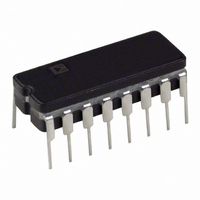AD652AQ Analog Devices Inc, AD652AQ Datasheet - Page 6

AD652AQ
Manufacturer Part Number
AD652AQ
Description
IV V-F CONVERTER SYNC 16-CDIP
Manufacturer
Analog Devices Inc
Type
Voltage to Frequencyr
Specifications of AD652AQ
Rohs Status
RoHS non-compliant
Frequency - Max
2MHz
Full Scale
±50ppm/°C
Linearity
±0.02%
Mounting Type
Through Hole
Package / Case
16-CDIP (0.300", 7.62mm)
Full Scale Range
1MHz To 2MHz
Linearity %
0.02%
Supply Voltage Range
± 6V To ± 18V
Digital Ic Case Style
DIP
No. Of Pins
16
Frequency Max
2MHz
Termination Type
Through Hole
Converter Function
VFC
Full Scale Frequency
2000
Power Supply Requirement
Single/Dual
Single Supply Voltage (max)
36V
Single Supply Voltage (min)
12V
Dual Supply Voltage (typ)
±15V
Dual Supply Voltage (min)
±6V
Dual Supply Voltage (max)
±18V
Operating Temperature (min)
-40C
Operating Temperature (max)
85C
Operating Temperature Classification
Industrial
Package Type
CDIP
Converter Type
Voltage to Frequency
Current, Quiescent Supply
±11 mA (Typ.)
Frequency Range
5 MHz (Typ.)
Input Impedance
20 Kiloohms
Number Of Pins
20
Temperature, Operating, Maximum
85 °C
Temperature, Operating, Minimum
-40 °C
Voltage, Range
±6 to ±18 V
Voltage, Supply
36 V
Filter Terminals
Through Hole
Rohs Compliant
No
Calibration Error Fs Typ
5%
Lead Free Status / Rohs Status
Not Compliant
Available stocks
Company
Part Number
Manufacturer
Quantity
Price
Company:
Part Number:
AD652AQ
Manufacturer:
TOSHIBA
Quantity:
670
AD652
THEORY OF OPERATION
A synchronous VFC is similar to other voltage-to-frequency
converters in that an integrator is used to perform a charge-
balance of the input signal with an internal reference current.
However, rather than using a one-shot as the primary timing
element, which requires a high quality and low drift capacitor, a
synchronous voltage-to-frequency converter (SVFC) uses an
external clock. This allows the designer to determine the system
stability and drift based upon the external clock selected. A
crystal oscillator may also be used if desired.
The SVFC architecture provides other system advantages
besides low drift. If the output frequency is measured by
counting pulses gated to a signal that is derived from the clock,
the clock stability is unimportant and the device simply
performs as a voltage-controlled frequency divider, producing a
high resolution A/D. If a large number of inputs must be
monitored simultaneously in a system, the controlled timing
relationship between the frequency output pulses and the user-
supplied clock greatly simplifies this signal acquisition. Also, if
the clock signal is provided by a VFC, the output frequency of
the SVFC is proportional to the product of the two input
voltages. Therefore, multiplication and A-to-D conversion on
two signals are performed simultaneously.
The pinouts of the AD652 SVFC are shown in Figure 2 and
Figure 3. A block diagram of the device configured as an SVFC,
along with various system waveforms, is shown in Figure 4.
10 VOLT INPUT
OP AMP OUT
OP AMP "–"
OP AMP "+"
TRIM
TRIM
+V
–V
S
S
1
2
3
4
5
6
7
8
20kΩ
SYNCHRONOUS
Figure 2. CERDIP Pin Configuration
VOLTAGE-TO-
FREQUENCY
CONVERTER
AD652
1mA
REFERENCE
AND
5V
D
SHOT
ONE
Q
Q
FLOP
"D"
CK
16
15
14
13
12
11
10
9
COMP REF
COMP "+"
COMP "–"
ANALOG GND
DIGITAL GND
FREQ OUT
CLOCK INPUT
C
OS
Rev. C | Page 6 of 28
Figure 4 shows the typical up-and-down ramp integrator output
of a charge-balance VFC. After the integrator output has
crossed the comparator threshold and the output of the AND
gate has gone high, nothing happens until a negative edge of the
clock comes along to transfer the information to the output of
the D FLOP. At this point, the clock level is low, so the latch does
not change state. When the clock returns high, the latch output
goes high and drives the switch to reset the integrator; at the
same time, the latch drives the AND gate to a low output state.
On the very next negative edge of the clock, the low output state
of the AND gate is transferred to the output of the D FLOP.
When the clock returns high, the latch output goes low and
drives the switch back into the Integrate mode. At the same
time, the latch drives the AND gate to a mode where it
truthfully relays the information presented to it by the
comparator.
Because the reset pulses applied to the integrator are exactly one
clock period long, the only place where drift can occur is in a
variation of the symmetry of the switching speed with
temperature.
Since each reset pulse is identical, the AD652 SVFC produces a
very linear voltage-to-frequency transfer relation. Also, because
all reset pulses are gated by the clock, there are no problems
with dielectric absorption causing the duration of a reset pulse
to be influenced by the length of time since the last reset.
OP AMP OUT
OP AMP "–"
OP AMP "+"
10V INPUT
5V INPUT
4
5
6
7
8
VOLTAGE-TO-FREQUENCY
10kΩ
10kΩ
16kΩ
Figure 3. PLCC Pin Configuration
SYNCHRONOUS
3
CONVERTER
9
AD652
10
2
1mA
4kΩ
1
AND
11
REFERENCE
SHOT
D
ONE
20
12
Q
Q
5V
FLOP
"D"
CK
19
13
NC = NO CONNECT
18
17
16
15
14
COMP "+"
COMP "–"
ANALOG GND
DIGITAL GND
FREQ OUT













